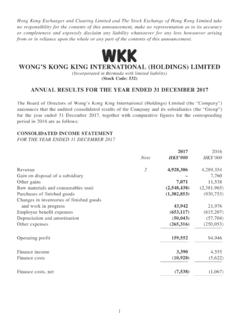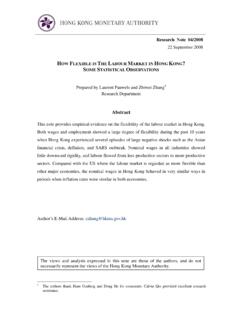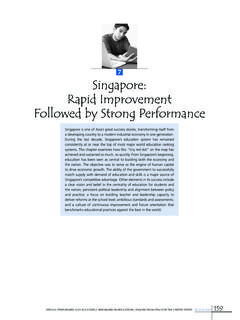Transcription of CALCULATING THE ECOLOGICAL FOOTPRINT AND …
1 1 Hong kong ECOLOGICAL FOOTPRINT Report 2013 AppendixCALCULATING THE ECOLOGICAL FOOTPRINT AND BIOCAPACITYThe National FOOTPRINT Accounts track individual countries use of ECOLOGICAL services and resources and the biocapacity available in each country. As with any resource accounts, they are static, quantitative descriptions of outcomes for any given year in the past for which data exist. Detailed calculation methodologies of the most recently updated Accounts are described in the Calculation Methodology for the National FOOTPRINT Accounts, 2011 Edition ( , 2011). Implementation of the National FOOTPRINT Accounts through database-supported templates is described in the Guidebook to the National FOOTPRINT Accounts (Kitzes et al. 2008) and the method paper by Borucke et al. (2013). Kitzes et al. (2009) outline the research agenda for future National FOOTPRINT Accounts, 2011 edition, calculates the ECOLOGICAL FOOTPRINT and biocapacity for 241 countries, territories and regions, from 1961 to 2008.
2 ECOLOGICAL FOOTPRINTThe National FOOTPRINT Accounts, 2011 edition, tracks human demand for biocapacity and compares it to how much biocapacity is available. There are five area types of biocapacity : cropland, grazing land, forests, fishing grounds and built-up land. Two biocapacity demand categories share the forest biocapacity : the Forest Product FOOTPRINT and the Carbon FOOTPRINT . The ECOLOGICAL FOOTPRINT of each major land use type is calculated by adding together the contributions of products and activities which compete for bioproductive space. Built-up land reflects the bioproductivity compromised by infrastructure and hydropower. The Carbon FOOTPRINT represents the carbon absorptive capacity of a world average hectare of forest needed to absorb carbon dioxide emissions from burning fossil fuels, after having the ocean sequestration capacity is removed from the equation. The ECOLOGICAL FOOTPRINT calculates the combined demand for ECOLOGICAL resources, wherever they are located, and presents this demand as the global average area needed to support a specific human activity.
3 This quantity is expressed in units of global hectares. A global hectare is defined as a biologically productive hectare with world average bioproductivity. By expressing all results as a common unit, biocapacity and the various Footprints can be directly compared across land use types and countries. Measurements of demand for resource production and waste assimilation are translated into global hectares by dividing the total amount of a resource consumed by the yield per hectare; and by dividing the waste emitted by the absorptive capacity per hectare. Yields are calculated based on various 2 Hong kong ECOLOGICAL FOOTPRINT Report 2013 Appendixinternational statistics, primarily those from the United Nations Food and Agriculture Organization (FAO ResourceSTAT Statistical Databases). Yields are mutually exclusive: if two crops are grown at the same time on the same hectare, one portion of the hectare is assigned to one crop and the remainder to the other.
4 This method avoids double counting and follows the same logic as measuring the size of a farm: each hectare is only counted once, even though it might provide multiple services. The ECOLOGICAL FOOTPRINT , in its most basic form, is calculated using the following equation: EF = D/Ywhere D is the annual demand of a product and Y is the annual yield of the same product (Borucke et al, 2013). Yield is expressed in global hectares. In practice, global hectares are estimated with the help of two factors: the yield factors, which compare national average yield per hectare to world average yield in the same land category; and the equivalence factors, which capture the relative productivity among the various land and sea area types. Taking into account these factors, the formula of the ECOLOGICAL FOOTPRINT becomes: EF = (P/YN)*YF*EQFwhere P is the amount of a product harvested or waste emitted (equal to D above), YN is the national average yield for P, and YF and EQF are the respective yield factors and equivalence factors for the country and land use type in question.
5 The yield factor is the ratio of national-to-world-average yields, which is calculated as the annual availability of usable products and varies by country and year. Equivalence factors translate the supply of or demand for an area of a specific land use type ( world average cropland or grazing land) into units of world average biologically productive area expressed in global hectares. These factors can vary by land use type and year. Annual demand for manufactured or derivative products ( flour or wood pulp) is converted into primary product equivalents ( , wheat or roundwood) through the use of extraction rates. These quantities of primary product equivalents are then translated into the ECOLOGICAL FOOTPRINT . The ECOLOGICAL FOOTPRINT also embodies the energy required during the manufacturing , PRODUCTION, AND TRADEThe National FOOTPRINT Accounts calculate the FOOTPRINT of a population from a number of perspectives. The most popular , or most widely-reported calculation is the ECOLOGICAL FOOTPRINT of the consumption of a population, typically just called ECOLOGICAL FOOTPRINT .
6 For a given country, the ECOLOGICAL FOOTPRINT of consumption measures the biocapacity demanded by the final consumption of all the residents of that country. In theory, the demand from visitors and tourists should be excluded, but in practice, the existing data does not allow that distinction to be 3 Hong kong ECOLOGICAL FOOTPRINT Report 2013 Appendixcalculated; and as a result the numbers reflect the consumption of all residents and visitors. For the same reason, the ECOLOGICAL demands made by Hong kong residents while travelling abroad are not included in this assessment. The final consumption figure includes the country s household consumption as well as their collective consumption, such as that made by schools, roads and fire stations, for example; which serve the households, but may not be directly paid for by the households. In contrast, a country s primary production ECOLOGICAL FOOTPRINT is the sum of the Footprints for all resources harvested and all waste generated within the country s geographical borders.
7 This includes the total area within a country required to support the actual harvest of primary products (cropland, grazing land, forest land and fishing grounds); the country s infrastructure and hydropower (built-up land), and the area needed to absorb fossil fuel-related CO2 emissions generated within the country (Carbon FOOTPRINT ). The difference between a country s Production and Consumption FOOTPRINT is trade, and is shown by the following equation: EFC = EFP + EFI - EFEwhere EFC is the ECOLOGICAL FOOTPRINT of consumption, EFP is the ECOLOGICAL FOOTPRINT of production, and EFI and EFE are the Footprints of imported and exported commodity flows respectively. BIOCAPACITYThe calculation of a country s biocapacity begins with the total amount of bioproductive land and sea available in that country. Bioproductive refers to areas of land and water that support significant photosynthetic activity and accumulation of biomass.
8 Barren areas of low or dispersed productivity are ignored. This is not to say that places such as the Sahara Desert, Antarctica, or the alpine environments of various countries do not support life; simply that their production is too widespread to be directly harvestable and is negligible in is an aggregate measure of the amount of area available, weighted by the productivity of that area. It represents the ability of a biosphere to produce crops, livestock (pasture), timber products (forest) and seafood; as well as the biosphere s ability to uptake CO2 in forests. It also measures how much of this regenerative capacity is occupied by infrastructure (built-up land). In short, it measures the ability of the available terrestrial and aquatic areas to provide ECOLOGICAL services. A country s biocapacity for any land use type is calculated as: BC = A*YF *EQFwhere BC is the biocapacity , A is the available area of a given land use type, and YF and EQF are the yield factors and equivalence factors, respectively, for the land use type in question in that kong ECOLOGICAL FOOTPRINT Report 2013 AppendixGLOSSARYASSETSD urable capital that is either owned or can be used in production, whether natural, manufactured, or human.
9 Assets are not directly consumed, but they yield products and/or services that people do consume. ECOLOGICAL assets are defined as the biologically productive areas of land and sea that generate the renewable resources and ECOLOGICAL services for which there is human demand. BIOCAPACITYThe ability of ECOLOGICAL assets to produce useful biological materials and ECOLOGICAL services such as absorbing the CO2 emissions generated by humans, using current management schemes and extraction technologies. biocapacity is measured in global hectares. Useful biological materials are defined as those which the human economy actually demanded in a given year. biocapacity includes only biologically productive land: cropland, forest, fishing grounds, grazing land and built-up land; deserts, glaciers and the open ocean are excluded. CARBON FOOTPRINTWhen used in ECOLOGICAL FOOTPRINT studies, the Carbon FOOTPRINT indicates the biocapacity required to sequester (through photosynthesis) the CO2 emissions produced by fossil fuel combustion.
10 Although fossil fuels are extracted from Earth s crust and are not regenerated in human time scales, their use creates a demand for ECOLOGICAL services if the resultant CO2 is not to accumulate in the ECOLOGICAL FOOTPRINT therefore includes a Carbon FOOTPRINT component, which represents the biocapacity (typically that of unharvested forests) needed to absorb the remaining portion of the fossil CO2 that is not absorbed by the ocean. The Carbon FOOTPRINT component of the ECOLOGICAL FOOTPRINT should not be confused with the Carbon FOOTPRINT indicator used in climate change debates. This latter indicates the tonnes of carbon (or tonnes of carbon per euro) that are directly and indirectly caused by an activity or are accumulated over the life stages of a product, rather than the ECOLOGICAL FOOTPRINT s carbon component, which measures demand on a bioproductive area (see Galli et al., 2012 for details).COMPETITIVENESSThe ability of a country to maintain and secure its of goods or services.






